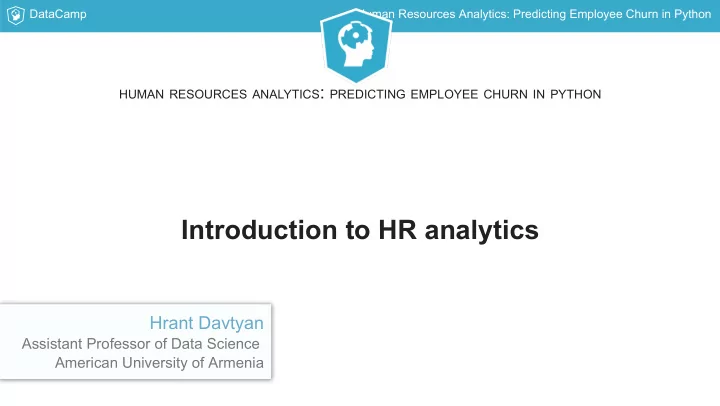

DataCamp Human Resources Analytics: Predicting Employee Churn in Python HUMAN RESOURCES ANALYTICS : PREDICTING EMPLOYEE CHURN IN PYTHON Introduction to HR analytics Hrant Davtyan Assistant Professor of Data Science American University of Armenia
DataCamp Human Resources Analytics: Predicting Employee Churn in Python What is HR analytics? Also known as People analytics Is a data-driven approach to managing people at work.
DataCamp Human Resources Analytics: Predicting Employee Churn in Python Problems addressed by HR analytics Hiring/Assessment Learning and Development Retention Collaboration/team composition Performance evaluation Other (e.g. absenteeism)
DataCamp Human Resources Analytics: Predicting Employee Churn in Python Employee turnover Employee turnover is the process of employees leaving the company Also known as employee attrition or employee churn May result in high costs for the company May affect company's hiring or retention decisions
DataCamp Human Resources Analytics: Predicting Employee Churn in Python Course structure 1. Describing and manipulating the dataset 2. Predicting employee turnover 3. Evaluating and tuning prediction 4. Selection final model
DataCamp Human Resources Analytics: Predicting Employee Churn in Python The Dataset In [1]: import pandas as pd data = pd.read_csv("turnover.csv") In [2]: data.info() Out [2]: <class 'pandas.core.frame.DataFrame'> RangeIndex: 14999 entries, 0 to 14998 Data columns (total 10 columns): satisfaction_level 14999 non-null float64 last_evaluation 14999 non-null float64 number_project 14999 non-null int64 average_montly_hours 14999 non-null int64 time_spend_company 14999 non-null int64 work_accident 14999 non-null int64 churn 14999 non-null int64 promotion_last_5years 14999 non-null int64 department 14999 non-null object salary 14999 non-null object dtypes: float64(2), int64(6), object(2) memory usage: 1.1+ MB
DataCamp Human Resources Analytics: Predicting Employee Churn in Python The Dataset (cont'd) In [1]: data.head()
DataCamp Human Resources Analytics: Predicting Employee Churn in Python Unique values In [1]: print(data.salary.unique()) array(['low', 'medium', 'high'], dtype=object)
DataCamp Human Resources Analytics: Predicting Employee Churn in Python HUMAN RESOURCES ANALYTICS : PREDICTING EMPLOYEE CHURN IN PYTHON Let's practice!
DataCamp Human Resources Analytics: Predicting Employee Churn in Python HUMAN RESOURCES ANALYTICS : PREDICTING EMPLOYEE CHURN IN PYTHON Transforming categorical variables Hrant Davtyan Assistant Professor of Data Science American University of Armenia
DataCamp Human Resources Analytics: Predicting Employee Churn in Python Types of categorical variables Ordinal - variables with two or more categories that can be ranked or ordered Our example: salary Values: low, medium, high Nominal - variables with two or more categories with do not have an instrinsic order Our example: department Values: sales, accounting, hr, technical, support, management, IT, product_mng, marketing, RandD
DataCamp Human Resources Analytics: Predicting Employee Churn in Python Encoding categories (salary) In [1]: # Change the type of the "salary" column to categorical data.salary = data.salary.astype('category') In [2]: # Provide the correct order of categories data.salary = data.salary.cat.reorder_categories(['low', 'medium', 'high']) In [3]: # Encode categories with integer values data.salary = data.salary.cat.codes Old values New values low 0 medium 1 high 2
DataCamp Human Resources Analytics: Predicting Employee Churn in Python Getting dummies In [1]: # Get dummies and save them inside a new DataFrame departments = pd.get_dummies(data.department) Example output IT RandD accounding hr management marketing product_mng sales support technical 0 0 0 0 0 0 0 0 0 1
DataCamp Human Resources Analytics: Predicting Employee Churn in Python Dummy trap In [1]: departments.head() IT RandD accounding hr management marketing product_mng sales support technical 0 0 0 0 0 0 0 0 0 1 In [1]: departments = departments.drop("technical", axis = 1) In [2]: departments.head() IT RandD accounding hr management marketing product_mng sales support 0 0 0 0 0 0 0 0 0
DataCamp Human Resources Analytics: Predicting Employee Churn in Python HUMAN RESOURCES ANALYTICS : PREDICTING EMPLOYEE CHURN IN PYTHON Let's practice!
DataCamp Human Resources Analytics: Predicting Employee Churn in Python HUMAN RESOURCES ANALYTICS : PREDICTING EMPLOYEE CHURN IN PYTHON Descriptive Statistics Hrant Davtyan Assistant Professor of Data Science American University of Armenia
DataCamp Human Resources Analytics: Predicting Employee Churn in Python Turnover rate In [1]: # Get the total number of observations and save it n_employees = len(data) In [2]: # Print the number of employees who left/stayed print(data.churn.value_counts()) In [3]: # Print the percentage of employees who left/stayed print(data.churn.value_counts()/n_employees*100) Out [3]: 0 76.191746 1 23.808254 Name: churn, dtype: float64 Summary Stayed Left 76.19% 23.81%
DataCamp Human Resources Analytics: Predicting Employee Churn in Python Correlations In [1]: import matplotlib.pyplot as plt In [2]: import seaborn as sns In [3]: corr_matrix = data.corr() In [4]: sns.heatmap(corr_matrix) In [5]: plt.show()
DataCamp Human Resources Analytics: Predicting Employee Churn in Python HUMAN RESOURCES ANALYTICS : PREDICTING EMPLOYEE CHURN IN PYTHON Let's practice!
Recommend
More recommend